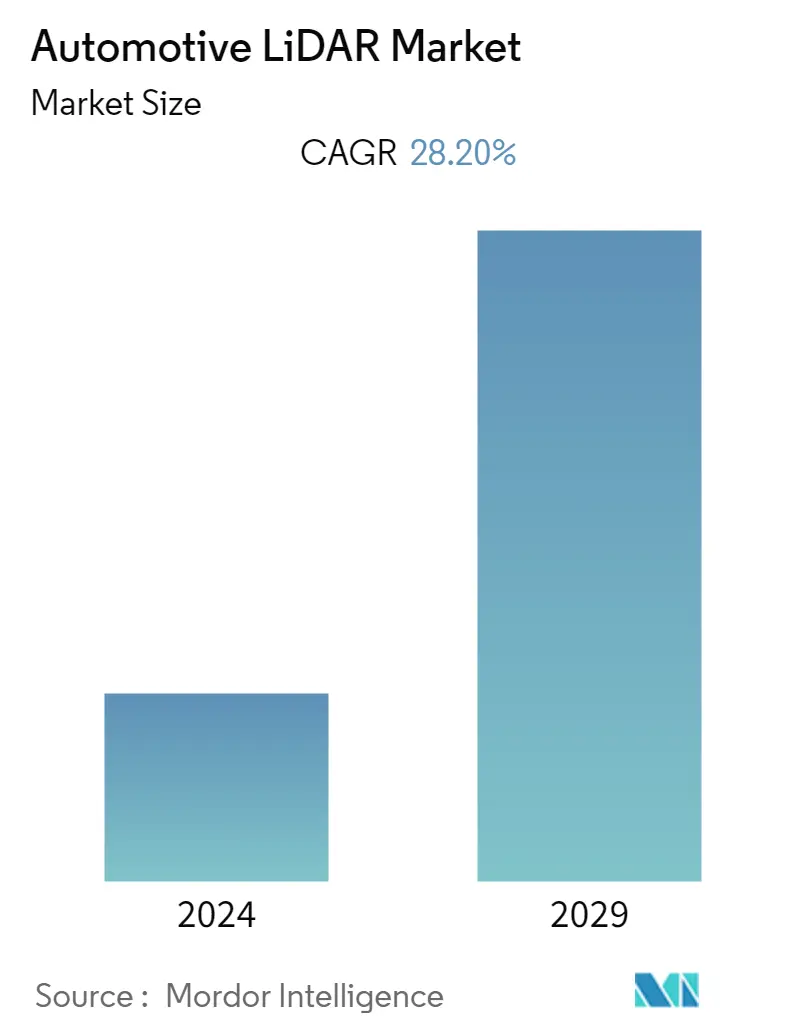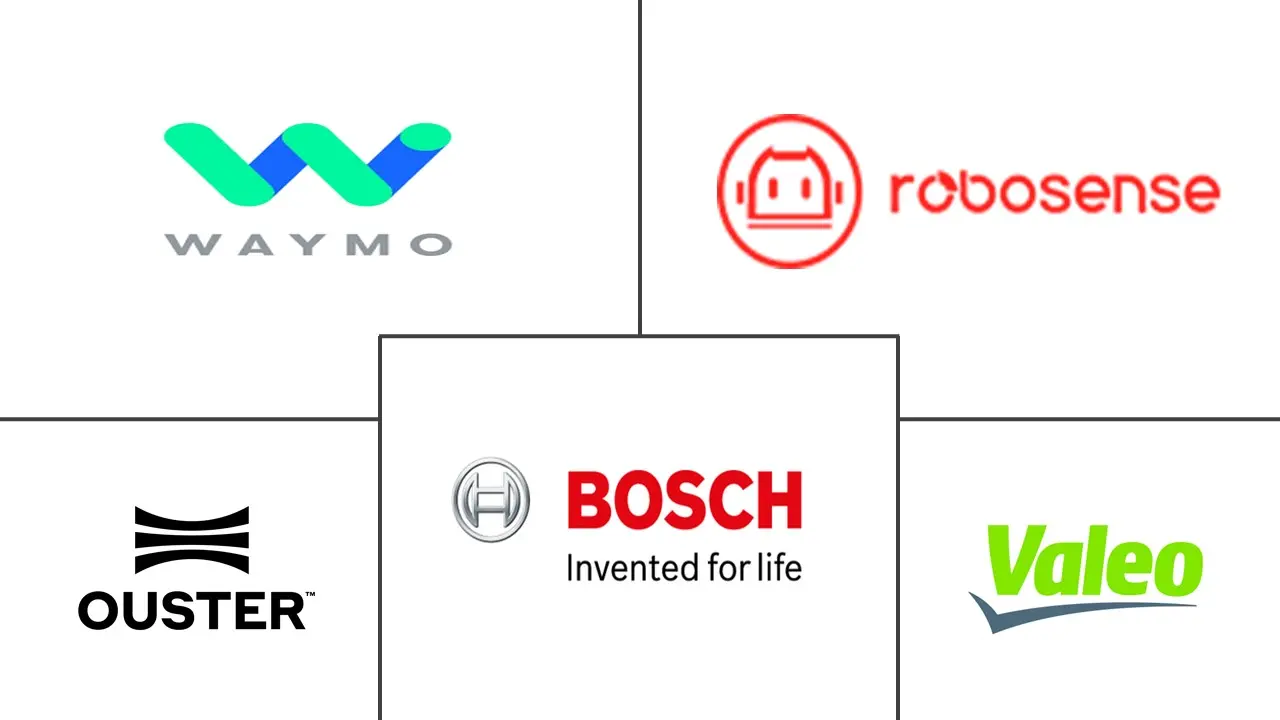Market Size of Automotive LiDAR Industry

| Study Period | 2019 - 2029 |
| Base Year For Estimation | 2023 |
| CAGR | 28.20 % |
| Fastest Growing Market | Asia-Pacific |
| Largest Market | North America |
| Market Concentration | High |
Major Players
*Disclaimer: Major Players sorted in no particular order |
Automotive LiDAR Market Analysis
The Automotive LiDAR Market is expected to reach 28.2% during the forecast period (2021 - 2026). The COVID-19 outbreak has affected industries across the globe. The automotive industry is one of the significant adopters of LiDAR. The outbreak has resulted in shutdown of various production plants impacting the demand. Semiconductor materials scarcity has further aggravated the situation.
The China Association of Automobile Manufacturers revised its predictions for 2020, forecasting a 10% drop in sales for the first half of the year and 5% for the full year, on account of the coronavirus outbreak According to the SMMT, car output would fall by 18% in 2020 as a result of COVID-19 closing all major UK plants.
- The entire automotive industry is looking forward to autonomous vehicles and assisted technologies. Automotive companies are coming up with innovative technologies in Advanced Driver Assistance Systems, using new and affordable sensors. For inclusive vehicle safety solutions, ADAS systems cannot be dependent on just vision and RADAR based systems; they require more efficient systems capable of providing highly accurate data for improved driver assistance.
- The growing trends in the automotive industry toward self-driving cars and electric vehicles are expected to be the critical drivers for newer applications of LiDAR. Self-driving cars increasingly use LiDAR sensors for generating huge 3D maps for 360° vision and for accurate information to assist in self-navigation and object detection.
- The emergence of LiDAR technology has provided an enormous growth potential to a wide range of enterprises, including Leddartech, Quantum Spatial, Geodigital, Topcon Positioning Systems, and Innoviz Technologies, among others, who have been relentlessly working toward introducing novel innovations in the business space. For example, Continental AG, a prominent name in automotive part manufacturing, announced expanding its LiDAR technology portfolio by investing a massive share in robotic vision and sensing pioneer- AEye.
- The latter's LiDAR technology boasts of the ability to trace small, low-reflective objects at a distance of mere 160 meters with multiple measuring points. It is suited to be vital for automated driving in both commercial and passenger vehicles.
- This investment would allow Continental to make extensive use of this LiDAR technology and industrialize the sensor to produce a fully automotive grade product, which stands as the major need of the hour across the automotive industry and autonomous vehicles.
- Furthermore, in April 2021, Velodyne and Ansys announced that they are developing software models of next-generation automotive lidar sensors to provide substantially improved hazard identification capabilities for highly advanced AVs. The collaboration incorporates Velodyne's lidar design into Ansys' virtual sensor suite and expedites automakers' integration of Velodyne's sensor into AVs - delivering industry-leading driving safety and a drastically faster path to market.
Automotive LiDAR Industry Segmentation
LIDAR - sometimes called time of flight (ToF), laser scanners or laser radar - is a sensing method that detects objects and maps their distances. The technology works by illuminating a target with an optical pulse and measuring the characteristics of the reflected return signal. The width of the optical pulse can range from a few nanoseconds to several microseconds. The study analyses the application of LiDAR in automotive industry. It provides a in-depth analysis of the application along with the extent of development and adoption in various geographies.
| By Application | |||||
| Robotic Vehicles | |||||
|
| By Geography | |
| North America | |
| Europe | |
| Asia-Pacific | |
| Rest of World |
Automotive LiDAR Market Size Summary
The Automotive LiDAR market is experiencing significant growth, driven by the increasing adoption of autonomous vehicles and advanced driver assistance systems (ADAS). LiDAR technology is crucial for enhancing vehicle safety and navigation by providing highly accurate 3D mapping and object detection capabilities. The automotive industry is rapidly evolving, with companies investing heavily in innovative LiDAR solutions to support the development of self-driving and electric vehicles. This technological advancement is supported by collaborations and investments from major players such as Continental AG, Velodyne, and Luminar, who are working on integrating LiDAR into vehicles to improve safety and reduce costs. The market is also witnessing the emergence of cost-effective solutions, such as solid-state LiDARs, which aim to replace traditional mechanical systems.
North America leads the Automotive LiDAR market, with the United States and Canada at the forefront due to their technological advancements and regulatory support for autonomous vehicles. The presence of key vendors and partnerships in the region is contributing to the market's growth. Despite the high costs associated with LiDAR technology, regulatory mandates and the push for safer transportation solutions are encouraging automakers to incorporate LiDAR into their vehicles. However, challenges remain, such as the need for cost-effective alternatives and the integration of LiDAR with existing neural network systems. The competitive landscape is characterized by high levels of innovation and marketing, with companies like Waymo and NAVYA making strides in deploying driverless vehicles and expanding their global presence.
Automotive LiDAR Market Size - Table of Contents
-
1. MARKET INSIGHTS
-
1.1 Market Overview
-
1.2 Industry Attractiveness - Porter's Five Forces Analysis
-
1.2.1 Threat of New Entrants
-
1.2.2 Bargaining Power of Buyers
-
1.2.3 Bargaining Power of Suppliers
-
1.2.4 Threat of Substitutes
-
1.2.5 Intensity of Competitive Rivalry
-
-
1.3 Market Drivers
-
1.3.1 Technological Superiority of LiDAR
-
1.3.2 Increasing Vehicle Safety Regulations and Growing Adoption of Adas Technology By OEM's
-
-
1.4 Market Challenges
-
1.4.1 High Cost of LiDAR Raises Overall Vehicle Cost
-
-
1.5 LiDAR Ecosystem (Photodetectors, IC, LiDAR Systems, Laser sources and Optical Components)
-
1.6 Integration of LiDAR in ADAS Vehicles (Advantages and Pain Points at Different Areas in the Vehicle)
-
1.7 Automotive LiDAR Technology Roadmap (2018 vs 2020 vs 2025)
-
1.8 Change in the Average Cost of LiDAR Technology in Automotive (Laser Ranging Sensor, High Resolution Spinning LiDAR mapping, Spinning & Solid State LiDAR for Positioning and Detection, and LiDAR for Mapping)
-
-
2. MARKET SEGMENTATION
-
2.1 By Application
-
2.1.1 Robotic Vehicles
-
2.1.2 ADAS
-
2.1.2.1 ADAS Level 2+ and 2++
-
2.1.2.2 ADAS Level 3 and Level 4
-
2.1.2.3 ADAS Level 5
-
-
-
2.2 By Geography
-
2.2.1 North America
-
2.2.2 Europe
-
2.2.3 Asia-Pacific
-
2.2.4 Rest of World
-
-
Automotive LiDAR Market Size FAQs
What is the current Automotive LiDAR Market size?
The Automotive LiDAR Market is projected to register a CAGR of 28.20% during the forecast period (2024-2029)
Who are the key players in Automotive LiDAR Market?
Ouster Inc., Robert Bosch GmbH, Waymo LLC, Robosense and Valeo are the major companies operating in the Automotive LiDAR Market.

